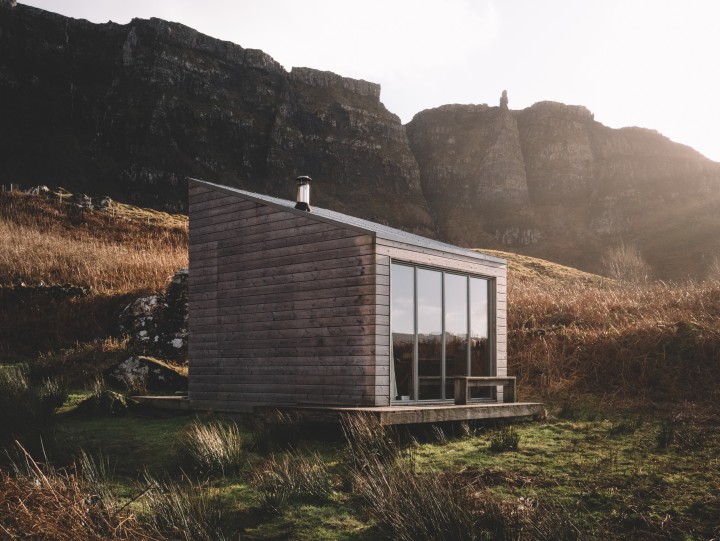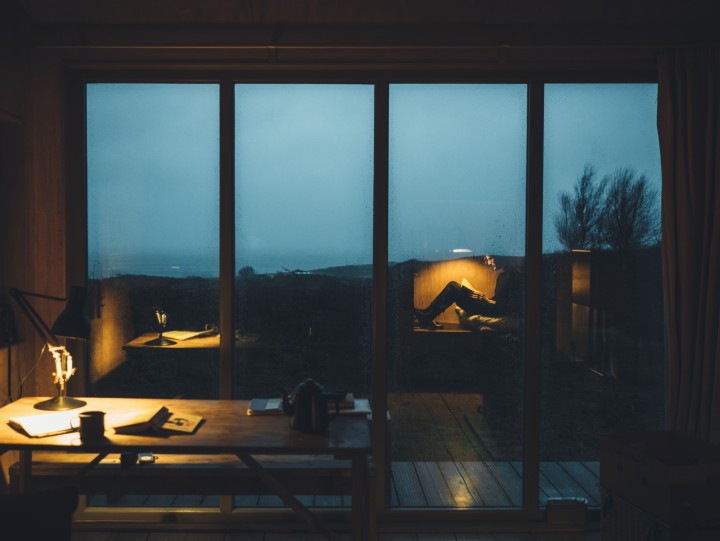Scottish Art News
Latest news
Magazine
News & Press
Publications
Wild Commons
By Greg Thomas, 13.04.2021

Sweeney’s Bothy nestles in the lap of a scrubby hillside on the north shore of the Isle of Eigg, the terrain sloping down dramatically to the quartz grains of the Singing Sands, beneath the cliffs of Cleadale. It’s a stunning location, and certainly conducive to solitary inspiration, but the story of the bothy’s creation, and of the island’s recent history more generally, is one of communal endeavour.
Designed in collaboration with the artist and poet Alec Finlay, the bothy is a product of Creative Scotland’s 2013 Year of Natural Scotland programme. Finlay’s design concept was inspired by the legend of the seventh-century Gaelic King Shuibhne (Sweeney), who spent ten years in the Irish wilderness surviving on sorrel, berries, sloes, and acorn, and sleeping – according to Flann O’Brien’s version of the story in At Swim Two Birds – atop a hawthorn bush, “every twist he would turn sending showers of hawy thorns into his flesh.” In keeping with the legend, at the centre of the bothy, a thorn-shaped support props up the bed above.
Finlay has described the concept behind the bothy as “hutopian,” part of a movement whereby spartan habitats are created in rural locations across Scotland as the basis for new models of creativity, social interaction, and ecological practice. (Think also of the land artist Julie Brook’s three years spent living in a natural arch on the west shore of Jura during the early 1990s.) The bothy has hosted a wide roster of artists over the last eight years, including through its funded Creative Practitioner residencies for artists, writers, musicians and craftspeople, and through programmes sponsored by the BALTIC Centre and William Grant Foundation. It is also part of the Bothy Project network, which supports similar spaces at Inshriach in the Cairngorms – a lodge created by architect Iain MacLeod and Bobby Niven – and on the grounds of the Scottish National Gallery of Modern Art, Edinburgh (the so-called Pig Rock Bothy, commissioned in 2014 as part of the Generation exhibition, celebrating 25 years of contemporary Scottish art.)
 Bothy Project, Sweeney's Bothy (interior). Photo courtesy Andrew Ridley.
Bothy Project, Sweeney's Bothy (interior). Photo courtesy Andrew Ridley.
The presence of Sweeney’s Bothy is also testament to the unique spirit of community that holds sway on Eigg. In 1997, the residents bought out the island following a string of lax and eccentric private owners (negligent land stewardship remains a problem in the Scottish north-west, a hangover from the era of feudal ownership). As a result of shared responsibility for the island’s resources, a multi-purpose community centre has been built, a renewable electricity grid established, and a lively, diverse, and increased population supported. Eigg has been a model for other rural communities across Scotland, prompting a slew of buyouts over the last twenty years.
In many ways, the spirit of Eigg, and of Finlay’s hutopianism, pervades the new residency scheme developed by the Bothy Project, though it also reaches across the Highlands, from Assynt and Coigach in the north to Badenoch and Strathspey in the east. The Neighbourhood Residencies project will support nine artists and community members to spend time at their local bothy – Sweeney’s, Inshriach, and the Assynt Art Studio, which joins the bothy network for this scheme – before connecting up remotely to share ideas and projects through a series of podcasts.
This idea of inter-regional communication encourages participants to think beyond insular notions of isolation and wildness that still pervade artistic conceptions of the Highlands and Islands, but which are increasingly challenged in Scottish ecological writing. So too, the opening out of the residency scheme to a wider array of bothy-dwellers – “people from all walks of life,” as the press release notes – should encourage rurally-based artists to situate their practice in relation to the many other types of work, and the diverse economic, social, and ecological systems, that interact with and support it.
 Bothy Project, Sweeney's Bothy. Photo courtesy Lucy Conway.
Bothy Project, Sweeney's Bothy. Photo courtesy Lucy Conway.
The writer and academic Sarah Bernstein, based in Coigach, taps into these possibilities with her outline for her planned stay. Bernstein is interested in the idea of “the commons,” physical and cultural assets seen as “ordinary and...shared – resources like water, land, air, but also spaces and forms of knowledge.” She hopes that her residency will allow local people to “share experiences of...sustainability,” and to explore “questions of housing justice and land reform,” vital to the survival of rural communities.
The larger cast of residents includes artists, such as Nethy Bridge-based choreographer Robbie Synge, but also craftspeople such as Fliss Fraser, based on the Isle of Rùm, community activists like Isebail MacKinnon from Canna, and educators such as Robyn Braham in Aviemore and Katrina Martin in Assynt. The other residents are Sarah Hobbs, founder of Strathspey Storywalks, social media expert Monika Strell, based in the Scottish Highlands, and Norah Barnes, an environmental scientist who set up the Earth Connections Eco Centre on Eigg.
The concept of the “hut” in literature and art often combines connotations of isolation and social connectedness. The hutopianism of this new residency scheme looks to harness those entwined impulses to encourage a new type of rurally embedded creative practice, extending beyond the boundaries of art to strengthen the bonds of working communities.




